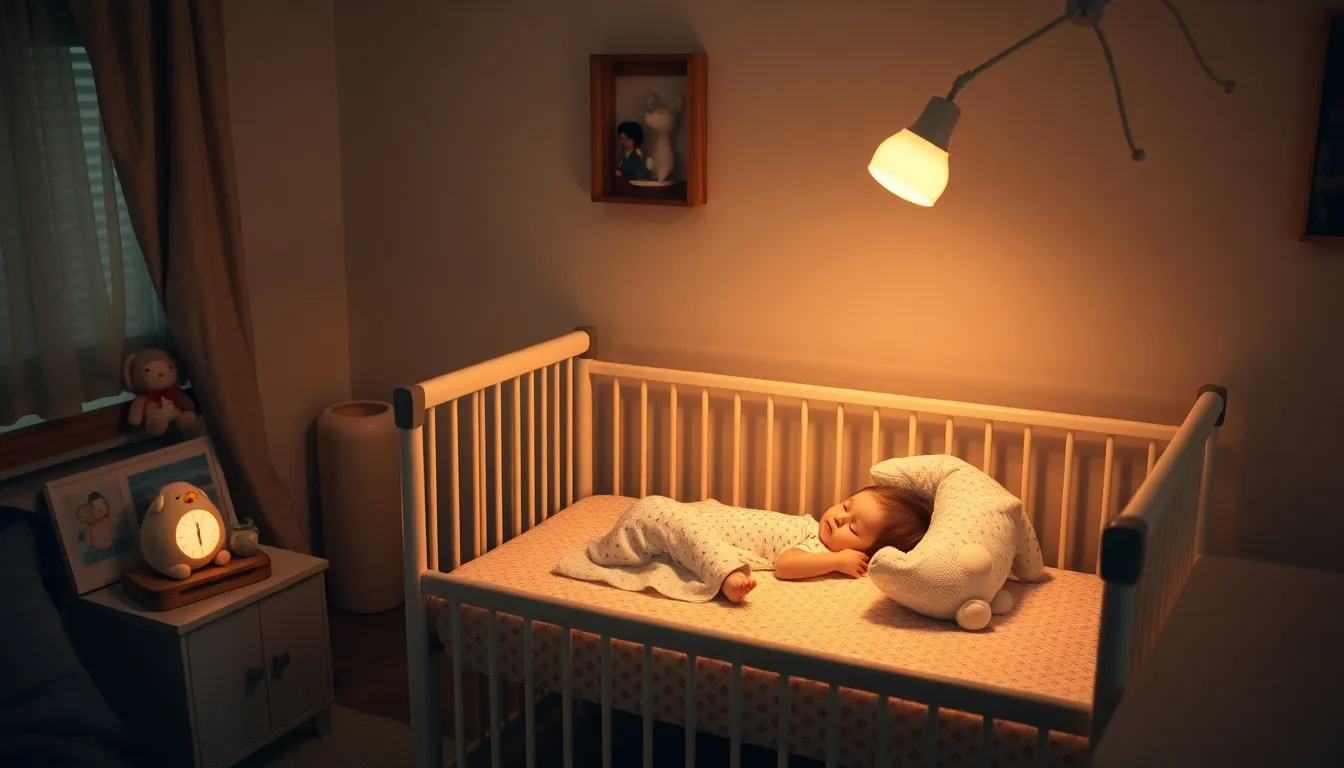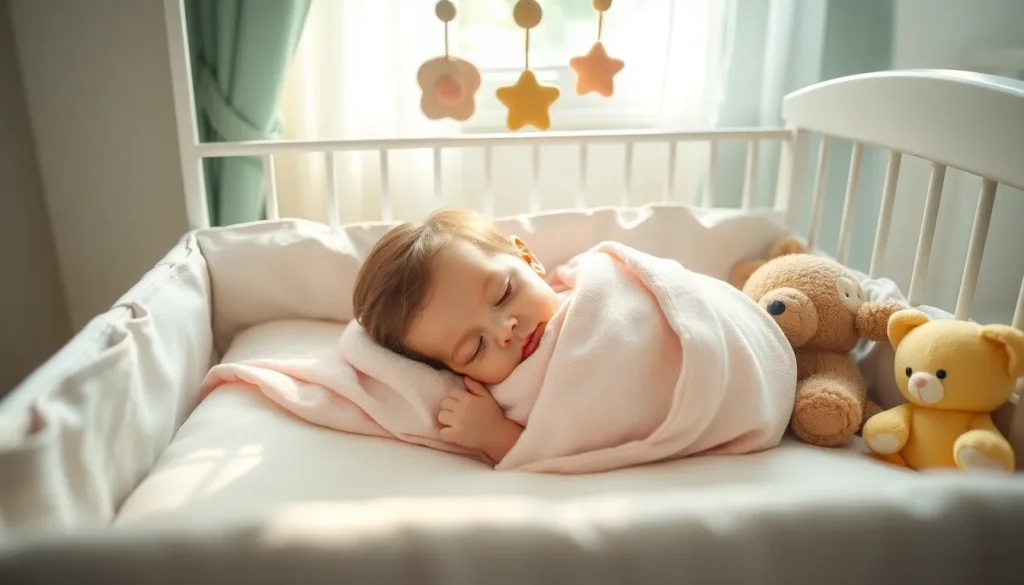Every parent knows the struggle of navigating their baby’s sleep patterns, but one mystery often leaves them scratching their heads: when do babies stop active sleep? Picture this: your little one is in dreamland, limbs flailing like they’re auditioning for a role in a toddler dance-off. Active sleep, also known as REM sleep, is a crucial part of their development, but it can make for some entertaining (and slightly alarming) moments for parents.
Table of Contents
ToggleUnderstanding Active Sleep in Babies
Active sleep, known as REM sleep, plays a crucial role in a baby’s sleep cycle. This phase involves rapid eye movement and body movement, making it distinct from other sleep stages.
Definition of Active Sleep
Active sleep signifies a unique phase in a baby’s sleep cycle characterized by increased brain activity. During this time, babies may twitch, smile, or make noises. It can occur several times throughout the night, often alternating with quiet sleep. Typically, active sleep accounts for about 50% of a newborn’s sleep. It helps babies experience vivid dreams and process information from their day.
Importance of Active Sleep for Development
Active sleep contributes significantly to a baby’s growth and development. This phase fosters brain development, supporting cognitive and emotional maturity. Babies engage in essential learning processes during active sleep, making neural connections. Evidence suggests that adequate active sleep correlates with better developmental milestones. Parents should recognize that this sleep stage is vital for memory consolidation and emotional regulation in infants.
Stages of Sleep in Infants

Understanding the stages of sleep in infants offers insights into their developmental needs. Infants experience several distinct sleep phases throughout the night.
Overview of Sleep Cycles
Newborns cycle through two main stages of sleep: active sleep and quiet sleep. During a typical sleep period, a baby may alternate between these phases every 50 to 60 minutes. Active sleep accounts for around 50% of total sleep duration in infants, characterized by rapid eye movements. Quiet sleep follows, marked by stillness and deeper relaxation, which occurs about 30-40% of the time. As babies grow, their cycles lengthen, leading to longer periods of quiet sleep and a reduction in active sleep.
How Active Sleep Differs from Other Stages
Active sleep stands out because of its heightened brain activity and physical movements. Infants often display twitching, smiling, or even vocalizations during this phase. In contrast, quiet sleep features minimal movement and a more stable heart rate. The transition between these stages influences memory consolidation and emotional regulation. Parents may notice more significant shifts in their baby’s sleep patterns as they develop, with active sleep decreasing and quiet sleep increasing over time.
When Do Babies Stop Active Sleep?
Active sleep gradually decreases as babies grow older. Parents often notice changes in sleep patterns, signaling the transition away from the active sleep phase.
Typical Age Range for Transition
Typically, babies start showing a decrease in active sleep around 6 months of age. Most infants experience a significant reduction in active sleep by 12 months. Parents may observe longer bouts of quiet sleep during this period. Developmental milestones often coincide with these changes. Each child is unique, and some may transition earlier or later than average. Individual sleep patterns can vary based on multiple factors.
Factors Influencing the Duration of Active Sleep
Several factors influence how long infants remain in active sleep. Genetics can play a role in sleep cycle duration. Environmental conditions, such as room temperature and noise levels, may affect sleep quality. Feeding schedules and overall health of the baby impact sleeping habits. Daily exposure to natural light influences circadian rhythms, which help regulate sleep-wake cycles. Lastly, parental habits and interventions can modify sleep behaviors and patterns significantly.
Common Myths About Baby Sleep
Many parents encounter misconceptions about their baby’s sleep patterns. Understanding these myths contributes to better sleep experiences for both infants and caregivers.
Misconceptions Surrounding Active Sleep
One common myth suggests that active sleep is unnecessary for infants. In reality, active sleep plays a crucial role in brain development and emotional growth. Another misconception implies that parents can influence the duration of active sleep. Factors like genetics and environment primarily determine sleep patterns. Some parents worry that frequent movements during active sleep indicate distress. However, this is a natural aspect of their development. Believing that all babies transition to quiet sleep quickly can lead to frustration, as infants cycle through sleep phases at their own pace.
Clarifying the Truth About Sleep Patterns
Differences exist in sleep patterns among individual infants. Active sleep typically comprises about 50% of a newborn’s sleep, gradually decreasing as they age. Most babies experience a shift to longer quiet sleep periods by six months. Parents may find it helpful to note that stimulation and feeding schedules can affect sleep cycles. Some believe that a lack of consistent sleep routines creates sleep issues. Establishing a healthy routine supports better sleep patterns, but natural variations still occur. Observing these changes can foster an understanding of a baby’s unique needs, helping parents feel more at ease.
Tips for Parents to Manage Sleep Transitions
Managing sleep transitions can be challenging for parents. Knowing a few key strategies helps create a smoother experience for both baby and caregiver.
Creating a Comfortable Sleep Environment
Establishing a comfortable sleep environment is crucial for infants. Dark curtains can block out excess light, promoting restful sleep. A consistent room temperature between 68°F and 72°F is recommended to avoid overheating. Soft, calming sounds or white noise can also provide reassurance. Investing in a firm, safe mattress supports healthy sleep. Regularly checking for safety hazards helps ensure a secure sleeping space. These adjustments lead to better quality sleep for babies.
Recognizing Sleep Cues
Recognizing sleep cues allows parents to respond effectively to their baby’s needs. Babies often display tired signs such as yawning or rubbing their eyes. Watching for movements can help identify when a little one is ready for sleep. Consistently noting these signals facilitates timely bedtime routines. Creating a calming pre-sleep routine reinforces good habits. A gentle rocking or quiet singing can ease the transition into sleep. Observing these cues fosters a stronger parent-child bond during this important phase.
Understanding when babies stop active sleep is key for parents navigating their infant’s sleep journey. As babies grow and develop, their sleep patterns evolve, leading to less active sleep and more quiet sleep. This transition typically begins around six months and continues into their first year.
Recognizing that each baby is unique helps parents manage expectations and adapt to their child’s specific needs. By fostering a calming sleep environment and responding to sleep cues, caregivers can support their baby’s natural sleep rhythms. Embracing these changes not only promotes better sleep for infants but also enhances the parent-child bond during this crucial developmental phase.










